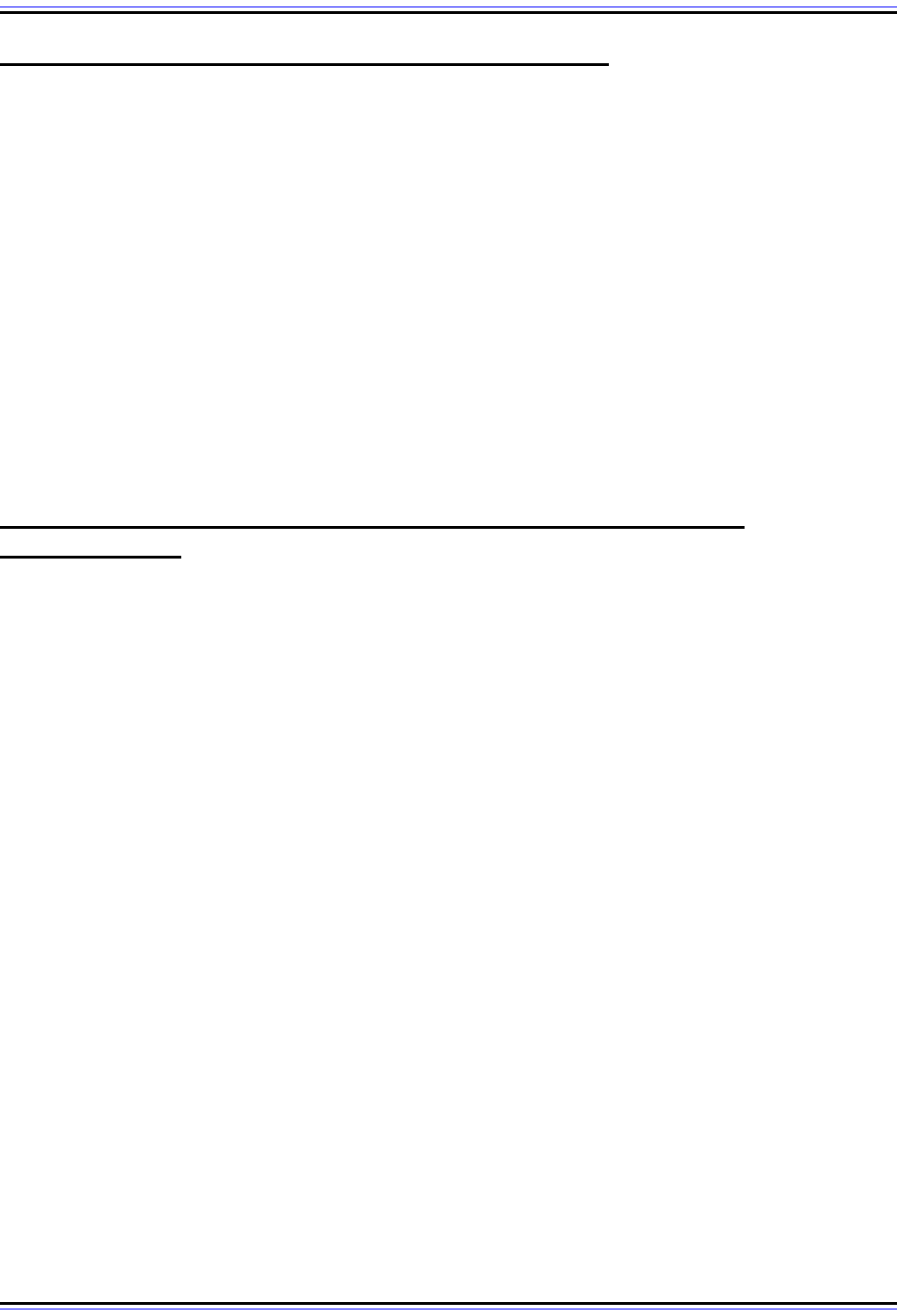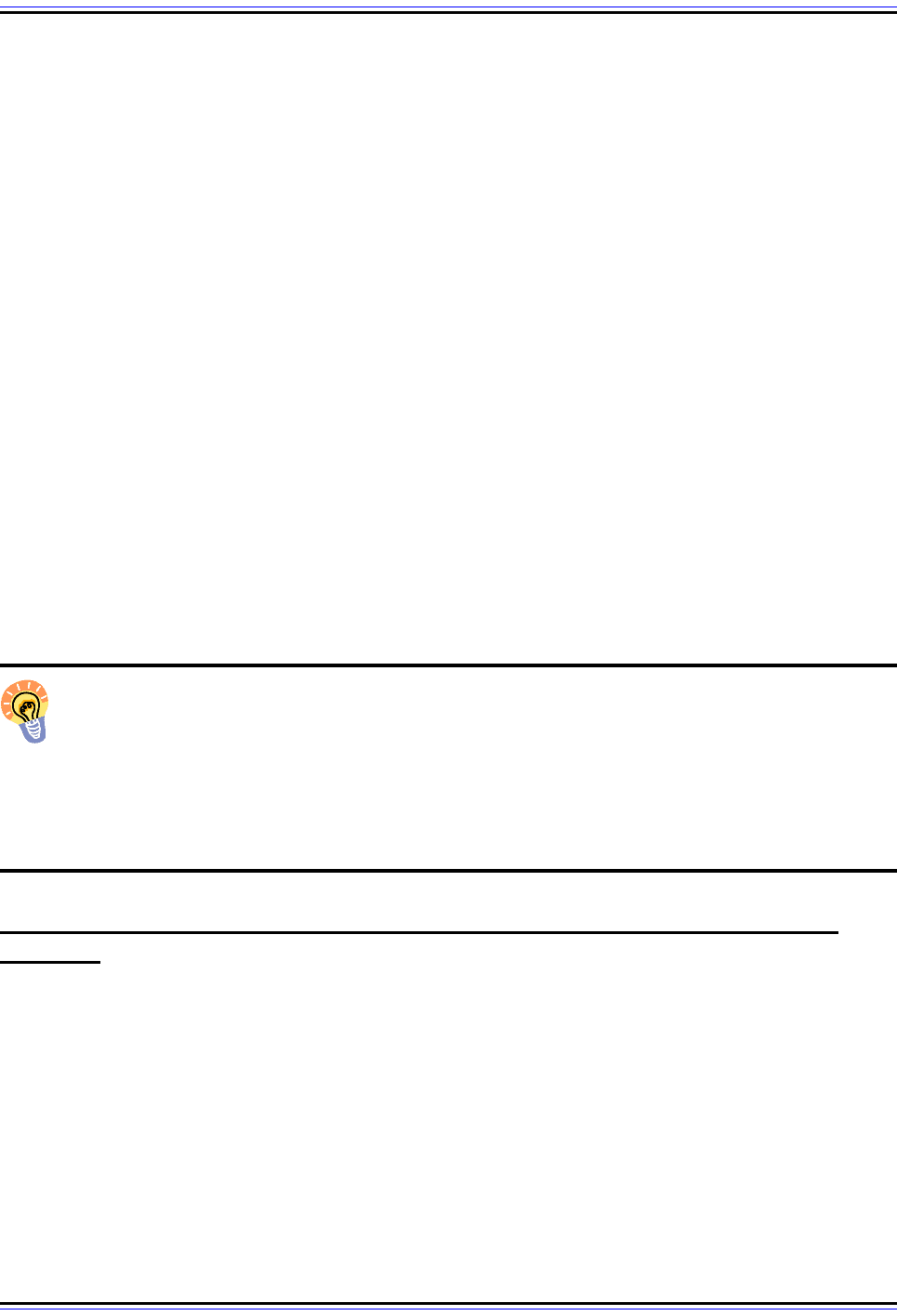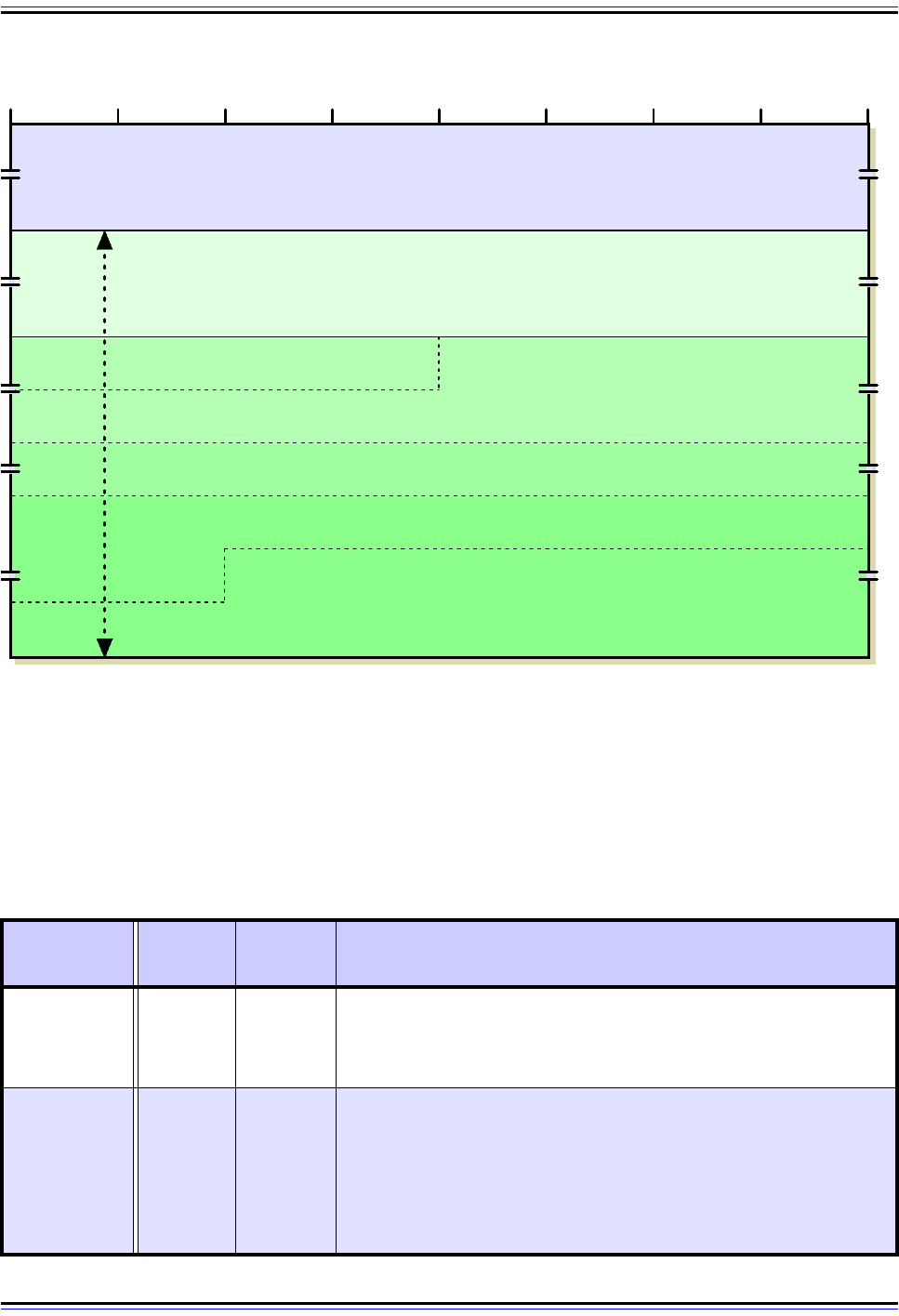Charles M. Kozierok The TCP-IP Guide
Подождите немного. Документ загружается.


The TCP/IP Guide - Version 3.0 (Contents) ` 1251 _ © 2001-2005 Charles M. Kozierok. All Rights Reserved.
In the real world, using polling to implement situations where critical information needs to be
sent would be like having the emergency response service in your town call everyone every
hour to find out if they needed an ambulance or fire truck. Similarly, in SNMP, a mechanism
was needed to let an SNMP agent initiate the communication of information. This capability
was originally made part of the SNMPv1 protocol through the inclusion of the Trap-PDU
message type.
In computer science, a trap is simply a set of conditions that a device monitors continuously.
If the appropriate conditions occur, the trap is triggered and causes some sort of action to
occur. In SNMP, traps are programmed into SNMP agents, and when they are triggered, an
SNMP Trap-PDU message is sent to an SNMP Manager to inform it of the occurrence.
Examples of traps in the SNMPv1 specification include ones that trigger in the event of a
communication link failure, restart of the device, or an authentication problem.
Use of SNMP Trap and Trapv2 Messages
The communication in the case of a trap is trivial; the SNMP Agent sends the trap and the
SNMP Manager is thereby considered “informed” of what happened. That's pretty much it.
These are “Unconfirmed” messages and no reply is made back to the SNMP Agent. The
triggering of the trap may lead the network administrator to take follow-up action at the
device that sent the trap.
The designer of a particular management information base must determine what traps to
create for a particular group of objects. The implementation must specify the conditions
under which the traps will trigger, and also the destination to which the Trap-PDU message
will be sent when this occurs. In SNMPv2, the original trap notification message was
retained in the form of the Trapv2-PDU message.
Use of the SNMPv2 InformRequest Message
SNMPv2 also incorporates a second notification message type: InformRequest-PDU. This
type of message is not the same as a trap, but it is related to traps for two reasons. First,
both message types are used to communicate information without the recipient initiating the
process, and second, the two messages are sometimes used in conjunction.
The purpose of the InformRequest-PDU is actually to facilitate the communication of infor-
mation between network management stations. The SNMP Manager on one NMS can
choose to “inform” another of some piece of information by sending an InformRequest-PDU
to that other SNMP Manager. The receiving manager then replies back with a Response-
PDU to the one that sent the InformRequest-PDU, confirming receipt of the inform
message.
A common way that this message is used is to “spread the news” when a trap occurs.
Suppose a device experiences a power failure, which results in a Trapv2-PDU being sent to
NMS #1. The network administrator may want to set up NMS #1 so that receipt of particular
traps causes the information in the trap to be “forwarded” to another. The InformRequest-
PDU would be used to carry that information from NMS #1 to say, NMS #2.

The TCP/IP Guide - Version 3.0 (Contents) ` 1252 _ © 2001-2005 Charles M. Kozierok. All Rights Reserved.
Key Concept: SNMP managed devices can inform a network management station
of an important occurrence by sending it a Trap-PDU or Trapv2-PDU message.
Network administrators determine the circumstances under which one of these
messages should be transmitted. SNMPv2 adds to this capability the InformRequest-PDU
message, which can be used to propagate information about an event between
management stations.
SNMP Protocol Security Issues and Methods
In my description of the various SNMP versions, it's possible that I may have been a bit
harsh on those who worked on SNMP during the 1990s. The proliferation of many SNMP
version 2 variants really was unfortunate, and not something we often see in the world of
TCP/IP. However, now that we've seen the sort of work that SNMP does, the need for
security in the protocol would seem to be clear. Given that, and given the very low level of
security in the initial SNMPv1 protocol, it's understandable to some extent why a conflict
over security issues arose.
Why Security is Important in SNMP
The need for security in SNMP is obvious because the MIB objects being communicated
contain critical information about network devices. We don't want just anyone “snooping”
into our network to find out our IP addresses, or how long our machines have been running,
or whether our links are down, or pretty much anything else. When it comes to object write
operations using SetRequest-PDU, the concerned are magnified even more: we definitely
don't want strangers being able to control or interfere with our managed devices by issuing
bogus commands to change MIB objects that control device operation!
SNMPv1 Security
Unfortunately, the security incorporated into SNMPv1 was extremely limited; it really took
the form of only one policy and one simple technology:
☯ “Weak Objects”: SNMP was created with the mindset that the MIB objects used in
the protocol would be relatively weak. This means that the objects are designed so
that any problems in working with them result in minimal damage. The policy of the
designers of SNMP was that MIB objects that are normally read should not contain
critical information, and objects that are written should not control critical functions.
So, a read-only MIB object containing a description of a machine is fine, but one
containing the administrative password is not. Similarly, a read-write MIB object that
controls when the computer next reboots is acceptable, but one that tells the object to
reformat its hard disk is (definitely) not!

The TCP/IP Guide - Version 3.0 (Contents) ` 1253 _ © 2001-2005 Charles M. Kozierok. All Rights Reserved.
☯ Community Strings: All the devices in an SNMP network managed by a particular set
of network management stations are considered to be in a “community”. Each
SNMPv1 message sent between members of the community is identified by a
community string that appears in a field in the message header. This string is like a
simple password; any messages received with the wrong string will be rejected by the
recipient.
These security features are better than nothing, but not much. The use of weak objects is
comparable to a policy that says not to leave your car in front of the convenience store with
the doors unlocked and the key in the ignition—it is basically saying “don't ask for trouble”.
This is wise, but it’s not a complete security solution. The community strings protect against
obvious tampering in the form of unauthorized messages. However, the strings are sent in
plain open text and can easily be discovered and then used to compromise the
“community”. So this is like locking your doors when parking your car—it protects against
the casual thief but not a pro.
Of course, for some people, not leaving their car running and locking the doors when they
park are enough security, and SNMPv1's security was also sufficient for some users of
SNMP. But in newer, larger internetworks, especially ones spanning large distances or
using public carriers, SNMPv1 wasn't up to the task. This is why all that fun stuff occurred
with SNMP version 2.
SNMPv2/v3 Security Methods
During the “evolution” of SNMPv2 variants, and eventually the creation of SNMPv3, several
new security models were created to improve upon SNMPv1's security:
☯ Party-Based Security Model: This was the security model for the original SNMPv2
standard, now called SNMPv2p. A logical entity called a party is defined for communi-
cation that specifies a particular authentication protocol and a privacy (encryption)
protocol. The information is used to verify that a particular request is authentic, and to
ensure that the sender and receiver agree on how to encrypt and decrypt data.
☯ User-Based Security Model (USM): This was developed in the SNMPv2u variant and
used in SNMPv2* (SNMPv2 asterisk); it eventually was adopted in SNMPv3. The idea
here is to move away from tying security to the machines and instead use more tradi-
tional security based on access rights of a user of a machine. A variety of
authentication and encryption protocols can be used to ensure access rights are
respected and to protect message privacy. The method relies on time stamps, clock
synchronization and other techniques to protect against certain types of attacks.
☯ View-Based Access Control Model (VACM): VACM is part of SNMPv3, and defines
a method where more fine control can be placed on access to objects on a device. A
view specifies a particular set of MIB objects that can be accessed by a particular
group in a particular context. By controlling these views an administrator can manage
what information is accessed by whom.

The TCP/IP Guide - Version 3.0 (Contents) ` 1254 _ © 2001-2005 Charles M. Kozierok. All Rights Reserved.
These descriptions are “grossly simplified”, to say the least. Security is probably the most
complicated subtopic in networking, and describing these methods in detail would require
dozens and dozens of topics. You can refer to the relevant standards if you want more infor-
mation, though unless you are well-read on security topics, you will likely not be able to
make heads or tails out of what is written in them.
Use of SNMP Security Methods
Party-based security pretty much died with SNMPv2p; USM and VACM are part of SNMPv3
and provide enhanced security for those who need it (though again, it's interesting to note
how many networks continue to use SNMPv1, security warts and all.) SNMPv3 took
another important security-related step in redefining the SNMP architecture to seamlessly
support multiple security models. This enables different implementations to choose the
security model that is best for them. USM is the default model in SNMPv3.

The TCP/IP Guide - Version 3.0 (Contents) ` 1255 _ © 2001-2005 Charles M. Kozierok. All Rights Reserved.
SNMP Protocol Messaging and Message Formats
As we saw extensively in the previous section, the communication of management infor-
mation is accomplished through the exchange of SNMP messages that contain protocol
data units (PDUs). Like the messages of most TCP/IP protocols, these PDUs are designed
to use a particular field format, and are created, addressed and transported according to
specific protocol rules. SNMP messages include fields that control the operation of the
protocol, and carry a “payload” of management information in the form of Management
Information Base (MIB) objects.
In this section I describe the details of how messaging is accomplished in the SNMP
Protocol. I begin with a general discussion of issues related to message generation,
addressing and transport, and a description of how retransmission of messages is handled
when necessary. I discuss the way fields are defined in SNMP messages and describe their
general format, explaining the difference between the overall message and the PDU it
contains. I then examine the message format used in all of the important SNMP versions,
showing the structure of each message type and the fields used.
SNMP Protocol Message Generation, Addressing, Transport and
Retransmission
The section on SNMP protocol operations described the way that SNMP messages are
employed to communicate network management information. Those discussions focused
primarily on the logical processes by which different tasks are accomplished using these
messages. Let's now take a closer look at the lower-level details of exactly how these
messages are created, addressed and sent by an SNMP device.
Message generation in SNMP is a bit different than the typical TCP/IP client/server model
used for most other protocols. There aren't really any formal “clients” and “servers” in
SNMP, since management information can be obtained from any device—it is distributed.
Most of the message exchanges use a matched pair of request and reply messages. The
network management station (NMS) usually acts as the client in these exchanges, sending
a particular get or set request to an SNMP agent, which plays the role of server for the infor-
mation it contains. However, SNMP agents aren't usually considered “servers” in the
conventional sense of the term.
SNMP traps deviate from the normal request/reply model of message generation entirely.
When a trap is triggered, an SNMP agent sends a trap message to a network management
station on its own, not in reaction to receiving a request. Since trap messages are uncon-
firmed there is no reply. Note, however, that the SNMPv2/v3 InformRequest-PDU message
is confirmed, and a response message is thus sent back to the NMS that generates it.
SNMP Transport Mappings
Once a message has been generated, it is sent using the protocols at the levels below the
application layer where SNMP resides. As we saw in the overview of the SNMP Protocol,
the current SNMP standard set separates description of protocol operations and PDUs from

The TCP/IP Guide - Version 3.0 (Contents) ` 1256 _ © 2001-2005 Charles M. Kozierok. All Rights Reserved.
the methods used to actually send them. Starting with version 2, SNMP has defined several
transport mappings that describe how SNMP PDUs can be sent over a variety of internet-
working protocol suites, including TCP/IP, OSI, IPX/SPX (Novell) and Appletalk.
Many of the specific details of SNMP messaging depend on the transport mapping that is
used in a particular implementation. SNMP is of course primarily used on TCP/IP internet-
works, and TCP/IP is where our main interest lies in this part of the Guide. I will therefore
continue this discussion by looking at transport issues when SNMP is used over IP.
SNMP Message Transport Using UDP
The standard IP transport mapping for SNMP calls for it to be carried using UDP. This
decision goes back to the initial implementation of SNMPv1 (before there were distinct
transport mappings.) UDP was likely chosen because it is more efficient for the simple
request/reply messaging scheme SNMP uses; the many TCP features were not considered
necessary and add overhead that SNMP's designers wanted to avoid. It is possible that
TCP could be used to carry SNMP, defined as a different transport mapping, but I don't
believe this is actually done.
Two well-known UDP port numbers are reserved for SNMP. The first is port 161, which is
the “general-purpose” SNMP number. All devices that are set up to listen for SNMP
requests—both agents and managers—listen on port 161. Each device receives any
messages sent and replies back to the “client”, the SNMP entity that issued the request,
which uses an ephemeral port number to identify the requesting process. The second UDP
port number is 162, which is reserved for SNMP traps. Having two numbers allows regular
messages and traps to be kept separate. Normally only NMSes would listen on port 162,
since agents are not recipients of traps.
The use of UDP allows SNMP information communication to be “streamlined”, since there
is no need to establish a TCP connection, and since message headers are shorter and
processing time slightly reduced. But the use of UDP introduces a couple of issues that
SNMP implementations must be concerned with.
UDP Message Size Issues
The first issue is that of message length. SNMP PDUs can carry many MIB objects, which
means they could potentially be rather large. However, UDP is limited in the size of
message it can carry (where TCP is not). The standards specify that SNMP entities must
accept messages up to at least 484 bytes in size. They also recommend that SNMP imple-
mentations be able to accept even larger messages, up to 1472 bytes, which would
correspond to the largest size message that can be encapsulated in an Ethernet frame
(1,500 bytes, allowing 20 bytes for the IP header and 8 for the UDP header.)
The use of the GetBulkRequest-PDU message type in SNMPv2/v3 requires particular care,
since it allows a single request to result in many MIB objects being sent back in a response.
The Max Repetitions parameter must be chosen conservatively so the SNMP agent doesn't
try to send an enormous message that won't fit.

The TCP/IP Guide - Version 3.0 (Contents) ` 1257 _ © 2001-2005 Charles M. Kozierok. All Rights Reserved.
Dealing with Lost Transmissions
The second issue with UDP is the price we pay for its efficiency and simplicity: a lack of
transport features. UDP doesn't guarantee data delivery or handle retransmissions, which
means a request or reply could in theory be lost in transit. Only the device that initially
sends a request can know if there was a problem with transport—it sends the request, and
if it receives no reply knows either the request or response got lost. This puts the responsi-
bility for retransmission on the part of the device that sends the request message.
NMSes sending requests to SNMP agents generally use a timer to keep track of how much
time has elapsed since a request was sent. If the response doesn't arrive within a certain
time interval, the request is sent again. Because of how SNMP works, having a request be
received more than once accidentally will normally not cause any problems (a property
known as idempotence). The NMS does need to employ an algorithm to ensure that it does
not generate too many retransmissions and clog the network (especially since congestion
might be causing the loss of its messages in the first place.)
Handling Lost Trap Messages
Since traps are unconfirmed, there is no way for the intended recipient of a trap PDU to
know if did not arrive, nor is there any way for the sender of the trap PDU to know. This is
just a weakness in the protocol; the overall reliability of TCP/IP (and the underlying
networks) ensures that these messages are not lost very often.
Key Concept: SNMP is designed with a separately-defined set of protocol opera-
tions and transport mappings, so it can be carried over many different
internetworking technologies. The most common of these is transport mechanisms is
TCP/IP, where SNMP makes use of UDP running over IP, for its efficient and simple
communication. The lack of reliability features in UDP means that requests must be tracked
by the device sending them and retransmitted if no reply is received. The limited size of
UDP messages restricts the amount of information that can be sent in any SNMP PDU.
SNMP Message Field Definitions, General Message Format and Message
Sections
To structure its messages for transport, SNMP uses a special field format, like most
protocols. What's interesting about SNMP, however, is that its standards do not describe the
SNMP message format using a simple list of fields the way most TCP/IP standards do.
Instead, SNMP messages are defined using the same data description language (Abstract
Syntax Notation 1 or ASN.1) that is used to describe MIB objects.
The reason for this is that SNMP messages implement the various SNMP protocol opera-
tions with the ultimate goal of allowing MIB objects to be conveyed between SNMP entities.
These MIB objects become fields within the messages to be sent. The MIB objects carried

The TCP/IP Guide - Version 3.0 (Contents) ` 1258 _ © 2001-2005 Charles M. Kozierok. All Rights Reserved.
in SNMP messages are defined using ASN.1 as described in the Structure of Management
Information (SMI) standard. So it makes sense to define SNMP messages and all their
fields using the same syntax.
Since all SNMP fields are defined like MIB objects, they are like objects in that they have
certain characteristics. Specifically, each field has a name, and its contents are described
using one of the standard SMI data types. So, unlike normal message formats where each
field has just a name and a length, an SNMP message format field has a name and a
syntax, such as Integer, Octet String or IpAddress. The syntax of the field defines its length
and how it is formatted and used.
Just as regular message formats use integers to represent specific values (for example, the
numeric Opcode field in the DNS message header, which indicates the DNS message
type), this can be done in SNMP using an enumerated integer type. An example would be
the Error Status field, where a range of integer values represents different error conditions.
The decision to define SNMP messages using ASN.1 allows the message format
description to be consistent with how the objects in the format are described, which is nice.
Unfortunately, it means that the field formats are very hard to determine from the standards,
because they are not described in one place. Instead, the overall message format is
defined as a set of components; those components contain subcomponents that may be
defined elsewhere, and so on. In fact, the full message format isn't even defined in one
standard; parts are spread across several standards. So you can't look in one place and
see the whole message format.
Well, I should say that you can't if you use the standards, but you can if you look here. To
make things easier for you, I have converted these “distributed” syntax descriptions into the
same tabular field formats I use throughout the rest of this Guide. I will begin here by
describing the general format used for SNMP messages, and in the next three topics
explore the more specific formats used in each version of SNMP.
General Message Format
To understand SNMP messages, it is important that we first grasp the difference between
SNMP messages and SNMP protocol data units (PDUs). We've seen in looking at SNMP
protocol operations that the two terms are often used interchangeably. This is because
each message carries one PDU, and the PDU is the most important part of the message.
However, strictly speaking, an SNMP PDU and an SNMP message are not exactly the
same. The PDU is the actual piece of information that is being communicated between
SNMP entities. It is carried within the SNMP message along with a number of header
fields, which are used to carry identification and security information. Thus, conceptually,
the SNMP message format can be considered to have two overall sections:
☯ Message Header: Contains fields used to control how the message is processed,
including fields for implementing SNMP security.
☯ Message Body (PDU): Contains the main portion of the message. In this case, the
message body is the protocol data unit (PDU) being transmitted.

The TCP/IP Guide - Version 3.0 (Contents) ` 1259 _ © 2001-2005 Charles M. Kozierok. All Rights Reserved.
The overall SNMP message is sometimes called a wrapper for the PDU, since it encapsu-
lates the PDU and precedes it with additional fields. The distinction between the PDU and
the message format as a whole began as a formality in SNMP version 1, but became quite
important in later versions. The reason is that it allows the fields used for basic protocol
operations (which are in the PDU) to be kept separate from fields used to implement
security features. In SNMPv2, the implementation of security became a very big deal
indeed, as we will see, so this flexibility was quite important.
General PDU Format
The fields in each PDU depend on the PDU type, but can again be divided into the following
general substructure:
☯ PDU Control Fields: A set of fields that describe the PDU and communicate infor-
mation from one SNMP entity to another.
☯ PDU Variable Bindings: A set of descriptions of the MIB objects in the PDU. Each
object is described as a “binding” of a name to a value.
Each PDU will follow this general structure, which is shown in Figure 276, differing only in
the number of control fields, the number of variable bindings, and how they are used. In
theory, each PDU could have a different message format using a distinct set of control
fields, but in practice, most PDUs in a particular SNMP version use the same control fields
(though there are exceptions.)

The TCP/IP Guide - Version 3.0 (Contents) ` 1260 _ © 2001-2005 Charles M. Kozierok. All Rights Reserved.
Each variable binding describes one MIB object. The binding consists of a pair of subfields,
one specifying the name of the object in standard SNMP object identifier notation, and one
its value, formatted to match the object's SMI syntax. For example, if the object is of type
Integer, the value field would be 4 bytes wide and contain a numeric integer value. Tab le
212 describes the subfield format for each PDU variable binding.
Figure 276: SNMP General Message Format
Table 212: SNMP Variable Binding Format
Subfield
Name
Syntax
Size
(bytes)
Description
Object Name
Sequence
of Integer
Variable
Object Name: The numeric object identifier of the MIB object,
specified as a sequence of integers. For example, the object
sysLocation has the object identifier 1.3.6.1.2.1.1.6, so it would be
specified as “1 3 6 1 2 1 1 6” using ASN.1
Object Value Variable Variable
Object Value: In any type of “get” request, this subfield is a “place-
holder”; it is structured using the appropriate syntax for the object
but has no value (since the “get” request is asking for that value!)
In a “set” request (SetRequest-PDU) or in a reply message
carrying requested data (GetResponse-PDU or Response-PDU),
the value of the object is placed here.
Message Header
PDU Control Fields
PDU Variable Binding #1
Object Name
4 8 12 16 20 24 28 320
...
PDU Variable Binding #1
Object Value
PDU Variable Binding #N
Object Value
PDU Variable Binding #N
Object Name
Message Body (PDU)
